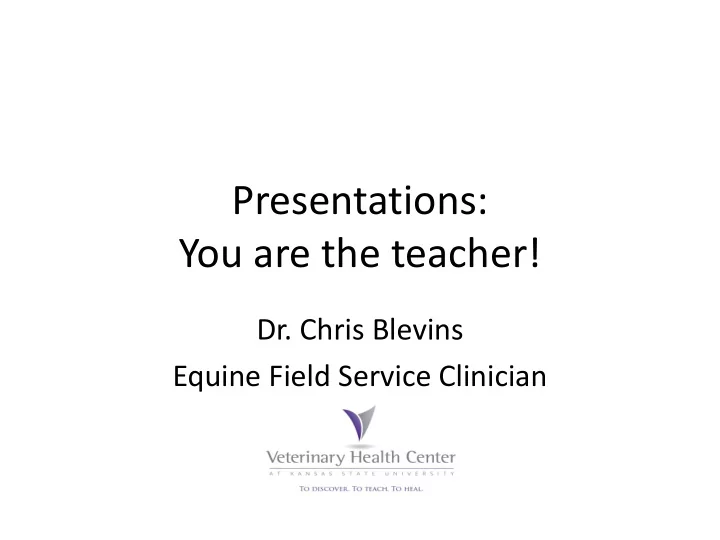

Presentations: You are the teacher! Dr. Chris Blevins Equine Field Service Clinician
Presentations • 3 main bullet points / slide • Read and follow – Nothing less than 20 pt font size – Font type is easy to read • Use pictures
Presentations • Educate/Advertise • Interact • Interesting topics – For you – For audience • KNOW YOUR AUDIENCE!!!!!!
Presentation • Following slides – Presentation I gave at Purina “Horse Owner Workshop” – Informal: stop and ask questions
Old age is not a disease, but their teeth…..? Dr. Chris Blevins Equine Field Service KSU-VHC http://us.123rf.com
Information • Geriatric horses – >15-20 years old – 273,600 geriatric horses in the U.S. • USDA: APHIS 2005 – Geriatric horses in vet clinics • 2.2% to 12.5% in a 10 year span (2003) – Veterinarians provided routine dental care for 49% of horses ≥ 20 years of age
Information – “Old Billy” black Shire in England • Oldest horse recorded • 62 years old when died – “Cooper” retired police horse in Missouri • 51 years old – “Scribbles” Welsh Pony in Wales UK • 51 years old
Information • “Charlie Brown” – 27 year paint horse gelding – Taught over 1200 veterinary students at KSU
Anatomy and Physiology • Chew pattern affected by feed – More processed feed stuff = More sharp points • Teeth continue to erupt from the gum line – Cheek teeth wear out by 25-30 years of age – All teeth can also get small
Examination • Complete physical exam! – Only 8% of geriatric horses seen for dentals had primary dental issues – Cushing disease, Heart murmurs, lameness/arthritis, laminitis, ect …..
Examination • History: – Quidding/Eating abnormal – Dropping grain/processed feed
Examination • Proper Sedation • Proper Equipment – Oral Speculum – Light source – Dental mirror – Oral dosing syringe – Head stand/halter
Examination
Examination
Treatment
Treatment • Incisor and Canine Teeth – Equine Odontoclastic Tooth Resorption and Hypercemetosis (EOTRH) • Aged (>15 years old) • Staged Extraction Steszyk et al. 2008
Treatment • Cheek teeth-diastemata/periodontal dz – Impaction of fibrous feed material – Dental Mirror or basket retractor to examine – Clinical signs: halitosis, quidding , buccal food packing, weight loss, and infections (bone and sinuses)
Treatment • Cheek teeth-diastemata/periodontal dz – Oral exam: dental mirror, basket retractors – Tx: +/- Widening Interdental Spaces • Diastema burr attachment • Caution: damage tooth/teeth
Treatment • Cheek teeth-diastemata/periodontal dz – Tx: Indirect treatments • Dietary modifications • Removal of Transverse Ridges • Reducing Occlusal Pressure on Diastemata • Extraction of Teeth • Reduction of Overgrown Teeth • Packing Diastemata with Plastic Impression Material
Treatment • Dietary Modification – Processed Feed Stuff • Pellet (complete feeds) • Alfalfa cubes • Chopped hay
Computerized Dental Charting Edward T. Earley, DVM; AAEP
Computerized Dental Charting
photostock.uwb.pl/.../640/horse_smile_640.jpg Chris Blevins, DVM (785)-532-5700 www.vet.ksu.edu
Recommend
More recommend